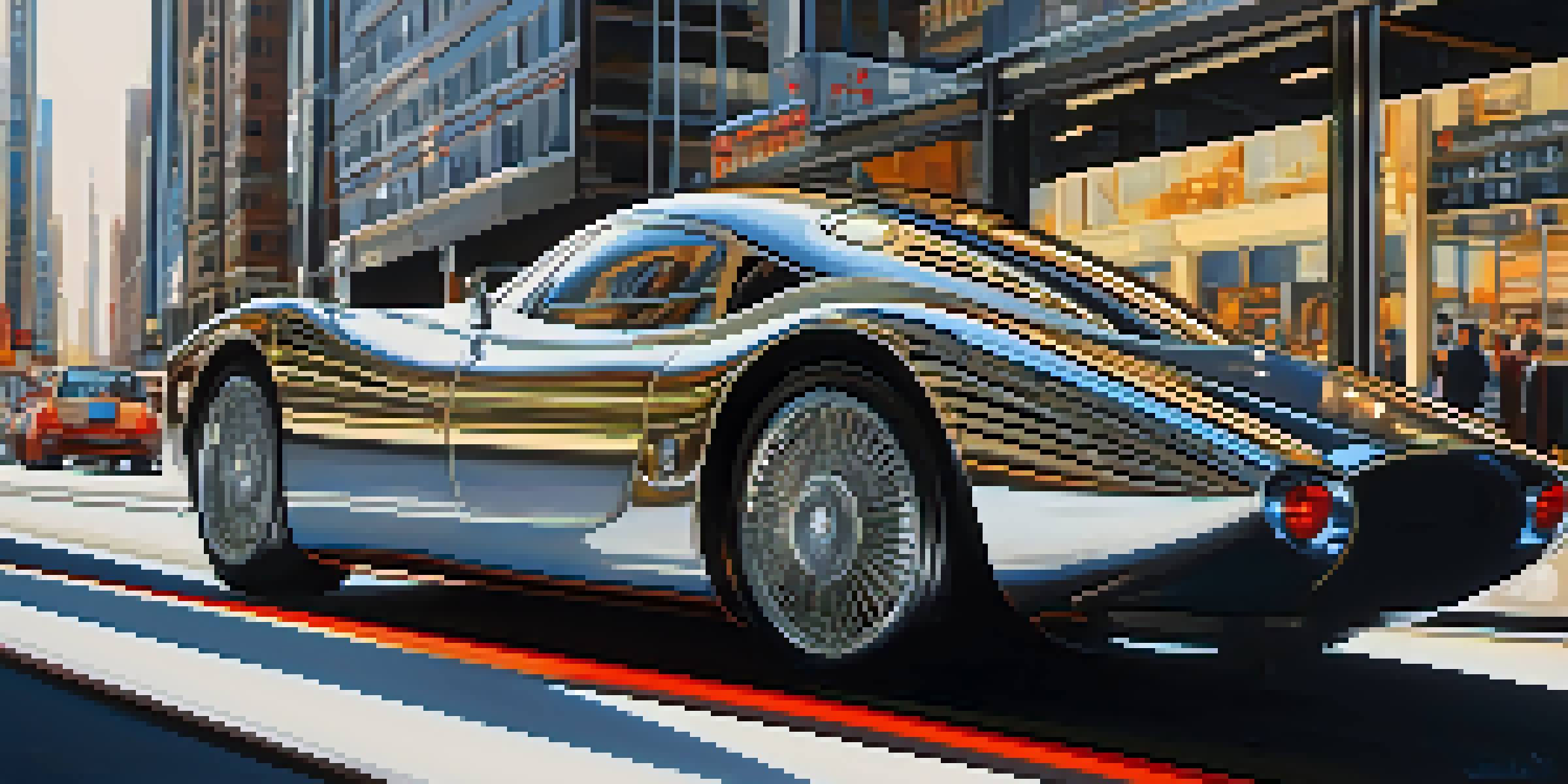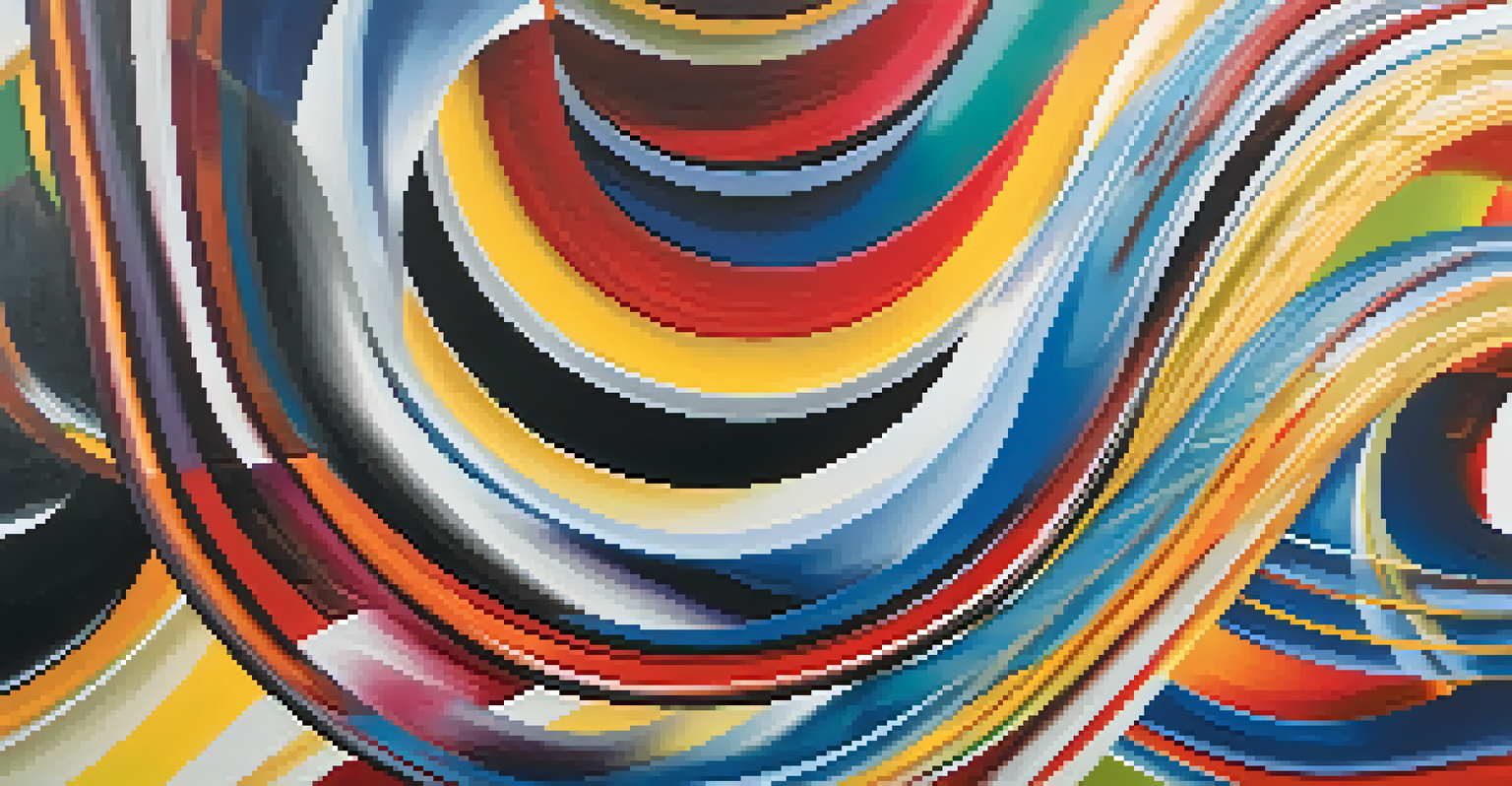Futurism and Movement: Capturing Motion in Art

Understanding Futurism: A Revolutionary Art Movement
Futurism emerged in the early 20th century, primarily in Italy, as a response to the rapid changes brought about by modern technology and urban life. Artists sought to capture the dynamism of contemporary life, moving away from traditional forms of representation. This movement celebrated speed, energy, and the beauty of machinery, reflecting the excitement of a new era.
The only way to deal with the future is to function efficiently in the now.
The Futurists believed that art should embrace the present and the future, rather than dwell on the past. They often rejected realism and instead focused on abstract forms and vibrant colors to convey movement and emotion. This shift in perspective marked a radical departure from previous artistic conventions and laid the groundwork for various modern art movements.
Key figures like Umberto Boccioni and Giacomo Balla emerged as leaders in this movement, producing iconic works that embodied the essence of Futurism. Their art not only depicted motion but also evoked a sense of urgency and the thrill of modern life, inviting viewers to experience the world in a new way.
The Role of Motion in Futurist Art
Motion is at the heart of Futurism, as artists sought to depict not just the physical movement of objects but also the sensation of speed and change. This dynamic approach often involved the use of multiple viewpoints and overlapping forms, creating a sense of fluidity in their work. For instance, Boccioni's 'Unique Forms of Continuity in Space' captures the essence of movement through its curvilinear shapes and bold lines.

Futurist artists employed techniques such as blurring and fragmentation, which allowed them to convey the experience of motion rather than just its representation. By breaking subjects into dynamic forms, they encouraged viewers to engage with the artwork actively, almost as if they were witnessing the action unfold in real-time. This innovation was a departure from static portrayals, inviting a deeper connection with the art.
Futurism Emphasizes Motion and Speed
The Futurist movement focused on capturing the dynamism of modern life through innovative techniques that depicted motion and energy.
The emphasis on motion also mirrored the societal changes of the time, where technology and industrialization were reshaping everyday life. Futurists aimed to embody the spirit of this new world, emphasizing how interconnected and fast-paced life had become, a theme that resonates in their works.
Techniques Used to Capture Motion
Futurist artists employed a variety of innovative techniques to capture motion effectively in their art. One prominent method was the use of dynamic lines, which suggested movement and direction, guiding the viewer's eye across the canvas. These lines often intersected and overlapped, creating a sense of rhythm and energy that reflected the frenetic pace of modern life.
Art is a machine that makes the world more beautiful.
Another technique was the incorporation of motion blur, which visually represented the speed of moving objects. This approach allowed artists to create a sensation of rapidity, making viewers feel as though they were part of the scene. By blending figures and backgrounds, Futurists achieved a striking contrast between stillness and motion, enhancing the overall impact of their work.
Additionally, the use of color played a crucial role in conveying motion. Bright, contrasting colors were often applied in bold strokes, creating an energetic visual experience. This vibrant palette not only highlighted the subject matter but also evoked emotions associated with movement, further immersing viewers in the dynamic world of Futurism.
Futurism's Influence on Modern Art
Futurism has left an indelible mark on the landscape of modern art, influencing various movements such as Abstract Expressionism and Surrealism. Its focus on abstraction and the exploration of motion opened new avenues for artists to express their ideas and emotions freely. The principles established by Futurists paved the way for future generations to experiment with form and technique.
Many contemporary artists draw inspiration from the Futurist emphasis on movement, incorporating similar themes and techniques into their work. For instance, artists working with digital media often explore the concept of motion in innovative ways, reflecting the ongoing evolution of technology and art. This connection between past and present highlights the enduring relevance of Futurism.
Influence on Modern Art Forms
Futurism has significantly impacted various modern art movements, encouraging artists to explore themes of motion and abstraction in their work.
Moreover, the legacy of Futurism can be seen in various art forms, including photography, film, and even graphic design. As these mediums continue to evolve, the foundational ideas of capturing motion and the essence of modernity remain influential, reminding us of the transformative power of art in reflecting our changing world.
Futurism and the Age of Technology
The Futurist movement was deeply intertwined with the rise of technology during the early 20th century. Artists embraced the machine age, celebrating innovation and industrialization as vital components of modern life. They viewed technology not as a threat but as a catalyst for progress, inspiring a new artistic vision that mirrored the advancements of their time.
This relationship between Futurism and technology is evident in their artworks, which often featured machines, vehicles, and urban landscapes. For example, Balla's 'Dynamism of a Dog on a Leash' captures the movement of a dog and its owner in the bustling city, showcasing the intersection of life and machinery. Such portrayals reflect the excitement and chaos of urban environments, emphasizing the impact of technology on daily experiences.
As technology continues to shape our lives, the Futurist ethos remains relevant today. Contemporary artists often explore themes of technology and movement, challenging us to consider how these elements influence our perception of the world. This ongoing dialogue between art and technology underscores the enduring legacy of Futurism in contemporary society.
Key Artists and Their Contributions to Futurism
Several key figures stand out in the Futurist movement, each contributing unique perspectives and innovations. Umberto Boccioni is perhaps the most well-known, with works like 'The City Rises' showcasing his commitment to capturing movement and the energy of urban life. His exploration of form and space helped redefine the boundaries of painting and sculpture.
Giacomo Balla also played a crucial role in the movement, particularly with his focus on light and color. His painting 'Abstract Speed + Sound' demonstrates how he combined dynamic lines and vibrant hues to convey the essence of speed and rhythm. Balla's innovative approach continues to inspire artists seeking to integrate motion into their work.
Art and Technology Connection
Futurism’s celebration of technology reflects its integral role in shaping contemporary society and continues to inspire artists today.
Lastly, Carlo Carrà contributed significantly to Futurism with his unique interpretations of movement and light. His work often reflects the tension between stillness and dynamism, allowing viewers to experience the transformative power of art. Together, these artists and their contributions shaped the trajectory of Futurism, leaving a lasting impact on the art world.
The Lasting Legacy of Futurism in Art
Futurism's impact on art extends far beyond its initial emergence in the early 20th century. The movement's emphasis on motion, modernity, and technology has influenced countless artists and movements throughout history. Its principles continue to resonate in contemporary art practices, as artists explore new ways to depict movement and the human experience.
Moreover, the exploration of motion in art has become more relevant in our fast-paced, technology-driven society. Today's artists often seek to capture the essence of life in motion, reflecting the complexities of modern existence. The ideas and techniques developed by Futurists serve as a foundation for this ongoing exploration, encouraging artists to push boundaries and innovate.

As we look to the future of art, the legacy of Futurism remains a powerful reminder of the importance of embracing change and celebrating the energy of life. By continuing to draw inspiration from this movement, artists can ensure that the spirit of Futurism lives on, enriching our understanding of art and its role in our lives.